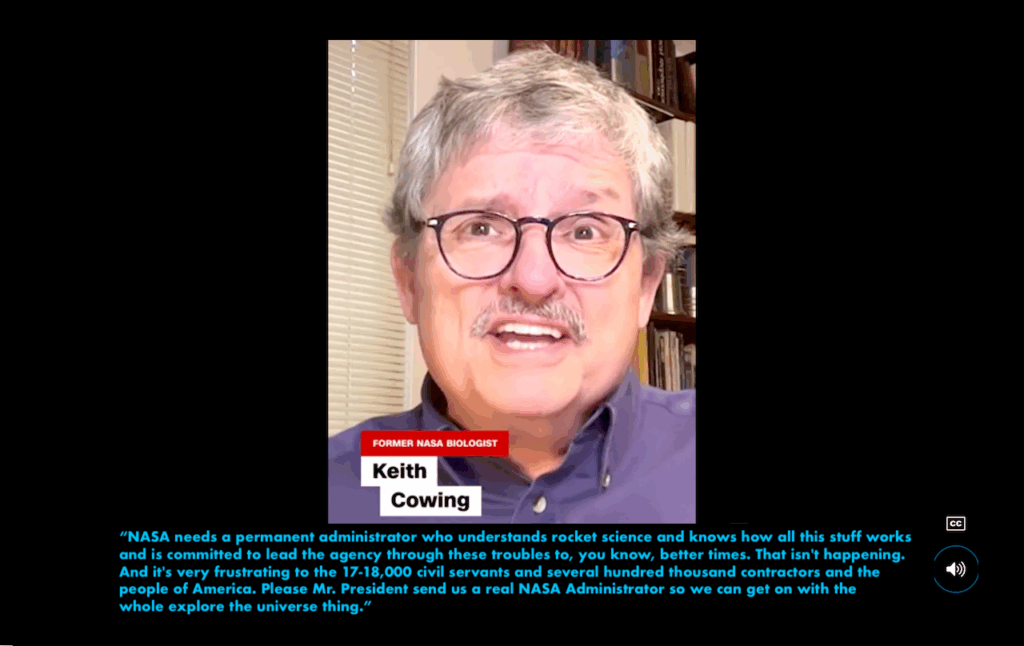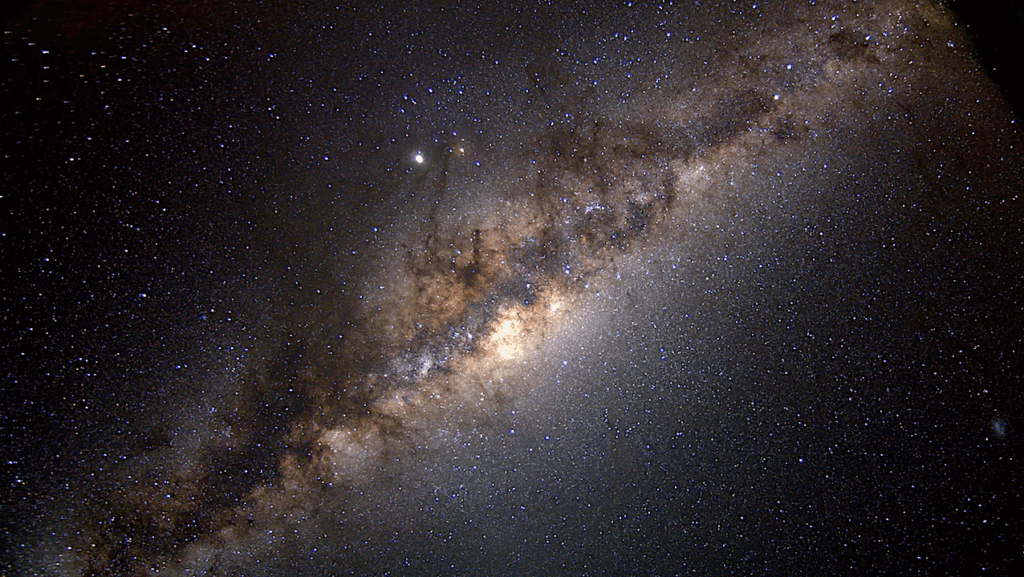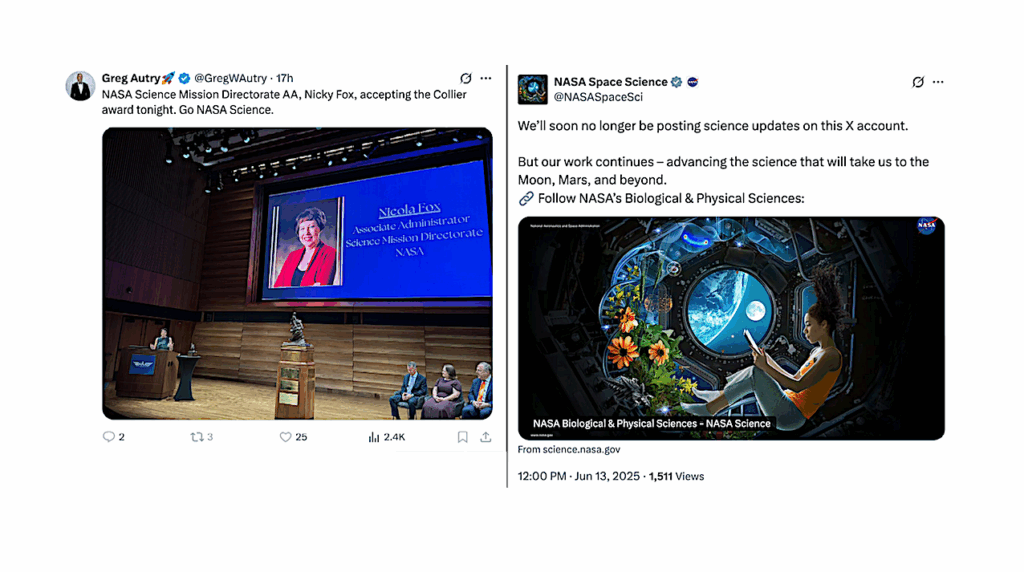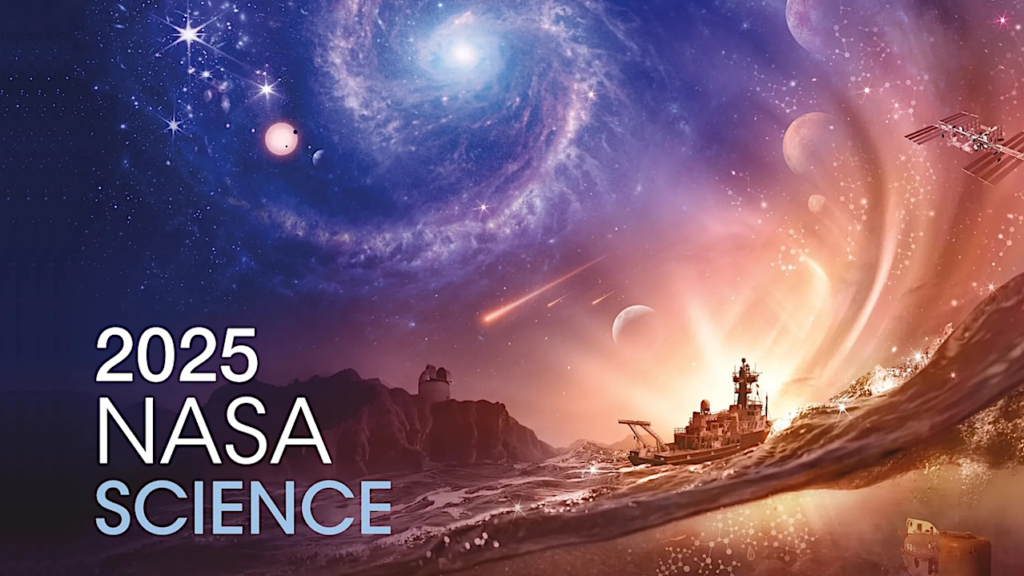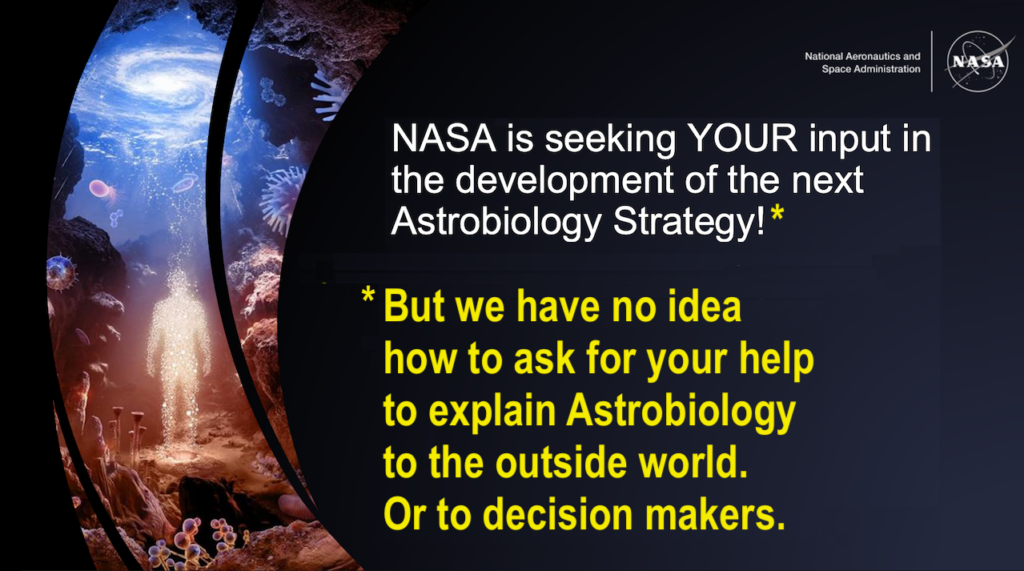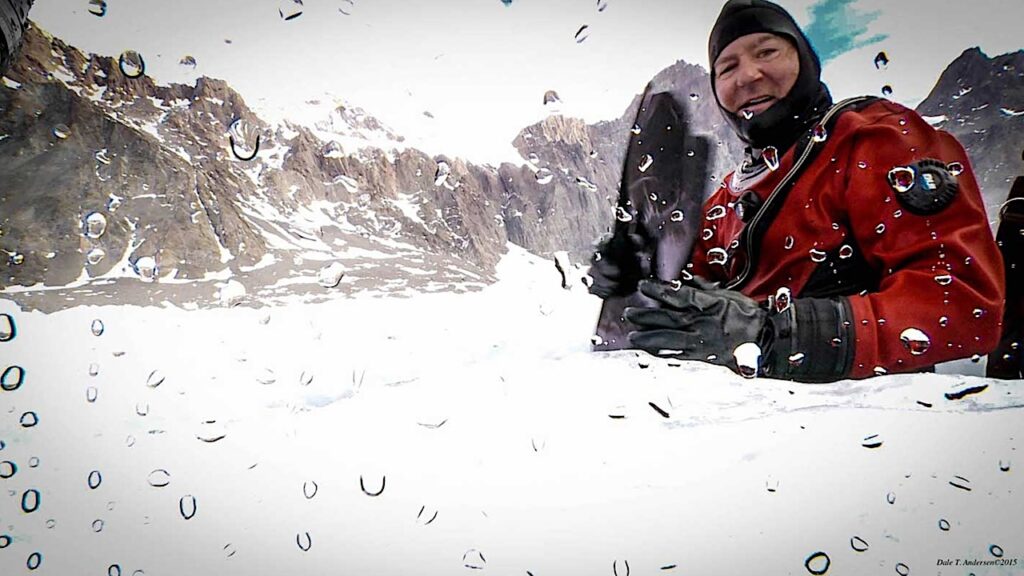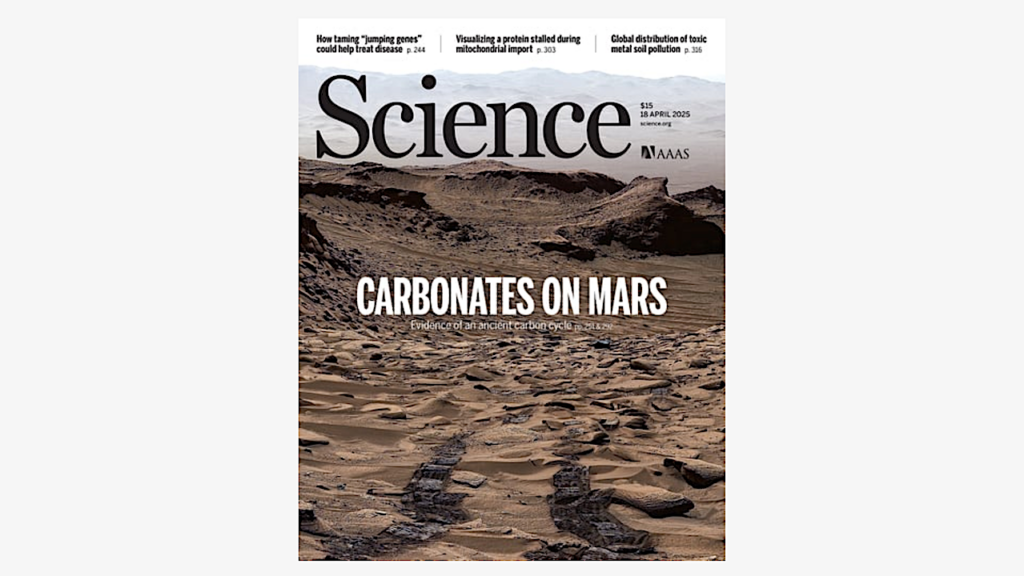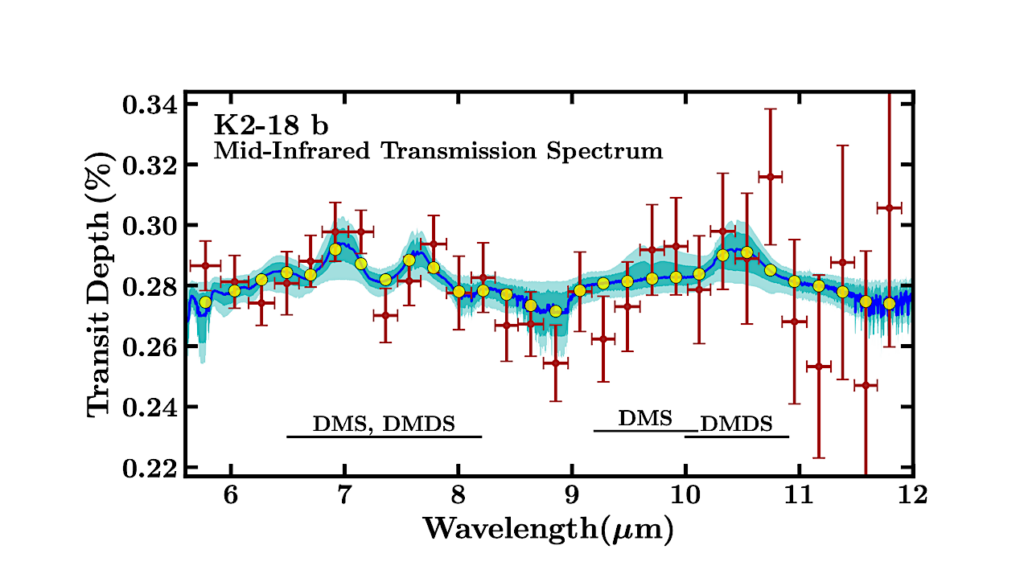Keith’s note: this web reel was just posted by CNN from the end of my interview this morning. OK, I have just about run out of ways / platforms to wave my arms and talk about what NASA needs in order to explore the universe. Your turn. “NASA needs a permanent administrator who understands rocket science and knows how all this stuff works and is committed to lead the agency through these troubles to, you know, better times. That isn’t happening. And it’s very frustrating to the 17-18,000 civil servants and several hundred thousand contractors and the people of America. Please Mr. President send us a real NASA Administrator so we can get on with the whole explore the universe thing.”
(more…)Keith’s note: Those of you in the space community know that NASA Science is facing an immense budget cut. Dozens of missions have been cancelled and many missions that are still returning valuable data are being shut off – in many cases to save a few million dollars – a tiny fraction of what it took to mount the missions in the first place. This data will be lost. In the case of New Horizons which is currently traversing the outer solar system, NASA is going to knowingly forfeit a third interstellar mission (after the twin Voyagers). This latest interstellar mission would be done with a healthy spacecraft outfitted with 21st century instrumentation. The Voyagers are minimally functional and will soon fade all together. We could continue to expand America’s pre-eminent exploration of interstellar space until the middle of this century. And that lead will last unchallenged for a generation or more to come. As I noted last month “This is not the way for America to lead the way out into the cosmos. Hopefully Congress will wake up and notice. Let’s ‘Keep America Great In Space’ — not abandon our lead.” More: Stellar Cartography: A Demonstration Of Interstellar Navigation Using New Horizons.
(more…)Keith’s note: As you have probably heard by now the elements that compose Earth and all of the life on it came from the stars. Meteorites from comets and asteroids constantly bombard our home world and sometimes cause dramatic changes to its environment. Radiation from our local star drives our ecosystems. Distant events such as supernovae and gamma ray bursts may directly impact life. We are made of star stuff as Carl Sagan once said – but were are still connected to things beyond out home world. Life forms can respond to gravity vectors, temperature and pressure changes, chemical gradients, Earth’s magnetic field, and radiation sources – all of which overlap and interact and have been shaping our world since it first formed. Another omnipresent feature has been the stars in the night sky. Due to the way Earth orbits the sun and the distant, slowly changing nature of star patterns, it is not surprising that various life forms evolved the ability to use the stars to navigate from one place to another for food, mating, hibernation etc. Some life forms even use lunar cycles (“months”) to drive their behavior. In the example below, Bogong moths use the night sky to guide them during long-distance travel. More at Astrobiology.com: Bogong Moths Use Stars In The Night Sky To Navigate Hundreds Of Kilometers
(more…)Keith’s note: Last night NASA SMD AA Nicky Fox was presented with the Collier Award for NASA’s Parker Solar Probe – an astonishing mission that has literally touched the sun. NASA Comptroller nominee Greg Autry congratulated her with a tweet adding “Go NASA Science”. This morning the @NASASpaceSci Twitter account announced that it was being shut down and swallowed into a larger effort somewhere at NASA. Yet another example of how the NASA FY 2026 budget and other Administration Executive Orders and memos have moved to gut NASA’s science budget, cancel missions, eliminate external research grants, stiff other space agencies with international agreements, and cut personnel. Weirdly, (soon to be) Administration personnel like Autry try to laud NASA science. Some political staff at NASA even try to take credit for missions started and launched by other presidents. Alas, Autry will preside over the cancellation of all these science activities and he’ll write glowing tweets about what he cut. It’s now all Flags and Footprints. Science is a buzz word used as hashtag windowdressing in social media. If Greg Autry wants to cheer on Science at NASA then he’ll need to support it too after he arrives.
(more…)“Dear ASGSR (American Society for Gravitational and Space Research) Members and Friends, As you may have heard, the President’s Budget Request (PBR) was recently released and includes severe cuts to NASA’s Science Mission Directorate. More specifically, NASA’s Biological and Physical Sciences Division (BPS), which funds a lot of our research, faces a draconian 72% reduction in funds from $87.5M to just $25M. This budget includes only $13M for Physical Sciences research, $4M for Space Biology, and $4M for the CERISS initiative.” More
(more…)Keith’s note: Thomas Zurbuchen was the longest serving Associate Administrator of the NASA Space Science Directorate. In this interview with Kristin Fisher, Zurbuchen warns that the proposed budget would send parts of NASA’s science portfolio “out of business,” undermine American leadership in space science, and risk a mass exodus of talent from NASA’s ranks. Link. Video below.
(more…)Keith’s note: On 25 May @ScienceMagazine tweeted a link to an article in Science Robotics magazine about a NASA Europa mission concept. So did @SciRobotics. The tweets referred to an article in the 21 May edition of Science Robotics: “Autonomous surface sampling for the Europa Lander mission concept“ written by 21 authors – all of whom work for NASA JPL, or related institutions. Cool stuff – yes? They have been testing it in Alaska. But the article is behind a paywall. I was able to find pieces of the article elsewhere – including a video – but without a subscription to Science Robotics I have to pay extra to read this article – an article written by NASA-funded people about a NASA-funded mission concept. I searched for “Europa lander” at NASA .gov and was sent to https://science.nasa.gov/mission/europa-lander/ which is a dead link and this page from 2017. NASA is supposed to be making these materials available to all taxpayers. But they don’t. Then the NASA folks moan and groan about missions being cut – and see that polls reflect public apathy toward NASA – when they simply do not have the initiative to highlight all of their cool stuff in the first place. NASA has easy access to immense social media, web, and TV audiences but PAO has no clue how to make the best use of this reach. Just sayin’. See: “Europa Astrobiology Lander Mission Concept: Autonomous Surface Sampling” at Astrobiology.com
(more…)Keith’s note: NASA’s Planetary Science Analysis/Assessment Groups have issued a document dated 6 May 2025, titled “AGness”. According to the authors (which has been annotated to enhance clarity, original document below), addressing members of the planetary science community: “The linked document below, The Keys of AGness, is a product of the collective Planetary Analysis and Assessment Groups (AGs), presented by their Chairs and vetted through their respective Steering/Executive Committees, and with community feedback. It captures what the community sees as the key pillars and important role of the AGs in the advancement of planetary science now and as we move into the future. The intended audience is multifold and includes NASA leadership, who are in the process of re-imagining the AG structure and support mechanism, and the broader planetary science community as a general reference and reminder of the forums, community building, support, repositories, and voice that the AGs provide.”
(more…)Keith’s note: According to “Slope Streaks on Mars – Not A Sign Of Water After All?” from Brown University: “A new study led by the University of Bern and Brown University in the U.S. casts doubt on one of the most tantalizing clues that water might be flowing on present-day Mars. Researchers analyzed a global database of 500,000 enigmatic streaks that occur on steep Martian slopes, concluding that they’re most likely caused by dry processes rather than liquid flow.” This could have important impacts on Mars exploration – by droids as well as humans. Remember that whole ‘water may be flowing on the surface of Mars’ thing back in 2000? (NASAWatch broke the story). People went totally crazy. Now there’s a suggestion that things are possibly different than we thought. Will NASA’s Astrobiology program mention it? Most likely not.
(more…)Keith’s note: Here we go again. With all the things being cut at NASA, you’d think that the NASA Astrobiology team would at least try and stand up and show their relevance. Guess again.
- The top story on NASA.gov Wednesday night is: “Another First: NASA Webb Identifies Frozen Water in Young Star System“ – Water Water Water 💧🫧💦🌧️ – it is one of the key things that Astrobiology looks for and thinks about. But there is no mention of this “First” discovery at @nasaastrobio or astrobiology.nasa.gov – and the scientific paper is behind a paywall. Update: here’s the paper on astro-ph https://arxiv.org/abs/2505.08863 – NASA still points to the paywall version.
- On Wednesday morning NASA and ESA announced “Webb’s Titan Forecast: Partly Cloudy With Occasional Methane Showers“ – interesting JWST studies of the atmosphere of Titan – a prime target for Astrobiology exploration – especially the $3 billion+ Dragonfly mission. But astrobiology.nasa.gov or @nasaastrobio make no mention. The scientific paper cited in the press release is behind a paywall (again).
- Is Astrobiology As Boring As NASA Thinks It is? (earlier post) – Next to searching for the origin of the universe, searching for life elsewhere in the cosmos is one of the most profound things NASA does. If only NASA would act that way.
Keith’s 13 May update: someone at NASA fixed the calendar page at astrobiology.nasa.gov. Nothing else was changed. FWIW the NASA search engine still does not know where that website is. Keith’s 10 May note: We’re all concerned about things going offline, cancelled etc. While we only have the “skinny” budget from OMB, it is obvious that big cuts are coming to NASA space science. You’d think that NASA Science Mission Directorate (SMD) disciplines would be standing up to show their stuff – their value – as a hedge against possible cuts. Some are. Others are not. Indeed NASA seems utterly uninterested in telling you that it is spending billions of dollars on Astrobiology research and missions. Next to searching for the origin of the universe, searching for life elsewhere in the cosmos is one of the most profound things NASA does. If only NASA would act that way.
(more…)Keith’s note: this just came out of my head as a stream of inter-related events. Some times I feel like Forrest Gump. Other times I am in Luke Skywalker mode. And this all happens inside a world not unlike the movie “Cloud Atlas” and sometimes the cult classic “Silent Running”. And at least once a day I go back to Everest Base Camp in my mind. Full post.
(more…)Keith’s note: as we resume lunar exploration and then head out to Mars and beyond in search of life, we will need a different mix of skills in the humans that we send out on these long terms expeditions to distant, alien places. Dale Andersen is a prototype of those future explorers. This is what he has been up to – And here’s news about the award: Astrobiologist Dale Andersen Receives Explorers Club Finn Roone Memorial Award: “Dale T. Andersen, PhD, a senior scientist at the Carl Sagan Center of the SETI Institute, has spent nearly five decades exploring Earth’s most extreme environments. A pioneer in scientific diving in Antarctica’s perennially ice-covered lakes, Andersen’s research focuses on microbial ecosystems in extreme settings, with studies in both Antarctica and the Arctic. His discoveries, including large, modern conical stromatolites in Lake Untersee, provide key insights into life on early Earth and serve as analogs for potential life on Mars and icy moons like Europa. Andersen’s work continues to inspire exploration, advancing public understanding of planetary science and the resilience of life.” P.S. The man in the picture below – third from the right is Sir Edmund Hillary.
(more…)Keith’s 18 April later update: NASA PAO finally started to post updates 24-36 hours after the rest of the world was reading about these discoveries everywhere except at NASA. Keith’s 17 April note: Two big Astrobiology/Space Science stories came out today based on NASA missions: JWST observations reveal possible exoplanet biosignatures (all over the news globally). Curiosity rover makes the cover of Science Magazine for carbonate discoveries on Mars. No mention of either is made at NASA.gov, astrobiology.nasa.gov, @NASA, @NASAAstroBio, or @NASASpaceSci. Everyone is worried about possible science cuts at NASA yet Public Affairs is utterly incapable of putting its own good news out for policy makers to see and consider. Baffling. Keith’s 18 April update: someone added a link about the Mars story to the NASA.gov page – but NASA Science Mission Directorate has not said anything about JWST biosignatures or Mars carbonates.
(more…)Keith’s note: Wow. The Curiosity rover has been driving around Mars since 2012. Yet it still does quality field geology work. Indeed, Science Magazine saw fit to put it on its cover – a distinction where major scientific discoveries often appear. See: NASA’s Curiosity Rover May Have Solved Mars’ Missing Carbonate Mystery.
(more…)Keith’s note: I was just on Bloomberg Radio/YouTube talking about the recent (possible) biosignature news of exoplanet K2-18 b and Astrobiology, while back on Earth, NASA’s budget cuts loom and how soon-to-be NASA-administrator Jared Isaacman is going to have to figure this all out. [Audio]
(more…)Keith’s note: Some interesting news from Cambridge University. Astronomers using the James Webb Space Telescope have detected “a tentative hint of dimethyl sulfide (DMS)“. A biosignature, simply defined, is a substance that is usually produced by life. It can often also have non-life sources. But usually when it is detected in certain circumstances it is a blinking light for something interesting. Follow-up research will be required – by multiple teams. As Carl Sagan is often quoted as saying “Extraordinary claims require extraordinary evidence”. NASA helped fund this research – research that is at the core of Astrobiology. Let’s see if they talk about it. Or not. To be clear: no one has discovered extraterrestrial life. At best they have noticed the hint – of a hint – of something that is worth looking into.
- According to “New Constraints On DMS and DMDS In The Atmosphere Of K2-18 b From JWST MIRI“: “Recent JWST transmission spectroscopy of the candidate hycean world K2-18 b in the near-infrared led to the first detections of carbon-bearing molecules CH4 and CO2 in its atmosphere, with a composition consistent with predictions for hycean conditions. The observations also provided a tentative hint of dimethyl sulfide (DMS), a possible biosignature gas, but the inference was of low statistical significance. … The results also highlight the need for additional experimental and theoretical work to determine accurate cross sections of important biosignature gases and identify potential abiotic sources. We discuss the implications of the present findings for the possibility of biological activity on K2-18 b.“
- According to “Strongest Hints Yet Of Biological Activity Outside The Solar System” from Cambridge University: “Using data from the James Webb Space Telescope (JWST), the astronomers, led by the University of Cambridge, have detected the chemical fingerprints of dimethyl sulfide (DMS) and/or dimethyl disulfide (DMDS), in the atmosphere of the exoplanet K2-18b, which orbits its star in the habitable zone. On Earth, DMS and DMDS are only produced by life, primarily microbial life such as marine phytoplankton. While an unknown chemical process may be the source of these molecules in K2-18b’s atmosphere, the results are the strongest evidence yet that life may exist on a planet outside our solar system.”
Keith’s note: According to this press release issued on Monday by Rep. Judy Chu CA-28, whose district includes JPL and Caltech: “Today, President Trump’s Office of Management and Budget (OMB) reportedly sent a preliminary budget plan to NASA that proposes a 50% cut to NASA’s Science Mission Directorate (SMD) and to eliminate funding for the Mars Sample Return (MRS) mission led by Jet Propulsion Laboratory (JPL), which is owned by NASA and administered by the California Institute of Technology (Caltech).” Full text below.
(more…)Keith’s note: (This stream of consciousness bubbled out of my head on a Sunday night) One of the potential victims of the upcoming NASA budget cuts is the Mars Sample Return. Its had its problems with cost and schedule and complexity. But what if you did not need to return the samples from Mars?
(more…)

